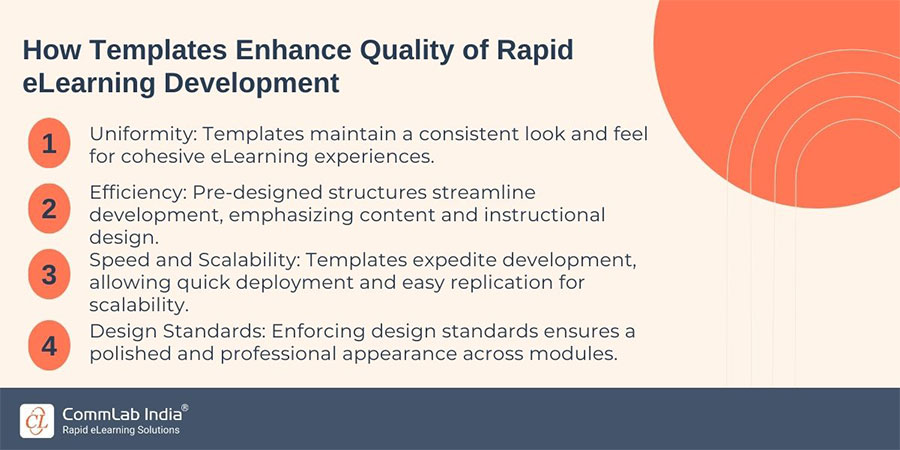11 Sure-Shot Ways to Ensure Quality in Rapid eLearning Development

Amidst the ever-evolving realm of corporate training, the hunger for prompt and impactful eLearning solutions intensifies. Rapid eLearning development serves as the keystone for meeting the immediate training exigencies of organizations. Yet, in the relentless pursuit of speed, the integrity of the learning experience must not waver. How, then, do we excel quality in rapid eLearning development, especially in the demanding arena of corporate training where excellence brooks no compromise?
Let's discuss...
The Need for Quality Assurance in Rapid eLearning
Rapid eLearning is characterized by its quick turnaround time, allowing organizations to deliver training content promptly. While speed is essential, maintaining high-quality standards is equally crucial. Corporate eLearning developers play a pivotal role in assuring the quality of eLearning modules, ensuring they align with organizational objectives and meet the needs of the learners.
Ways to Assure Quality in Rapid eLearning Development
1. Clear Learning Objectives: Guiding the Development Journey
Quality assurance in rapid eLearning development begins with clear learning objectives. Before diving into content creation, it is very important to define precise learning outcomes. This not only guides the development process but also ensures that the content directly contributes to the mastery of specific skills or knowledge areas.
Clear learning objectives are the North Star in rapid eLearning development, guiding every decision and ensuring the end result aligns with organizational goals
2. Collaborative Design and Review: Harnessing Collective Expertise
Fostering collaboration among instructional designers, subject matter experts (SMEs), and stakeholders is a cornerstone of quality assurance. Regular design reviews involving all stakeholders ensure the accuracy, relevance, and instructional soundness of the content.
Collaborative design and review processes positively impacted the quality of their eLearning content.
3. Effective Use of Templates: Balancing Consistency and Creativity
Templates are a valuable asset in rapid eLearning development. They not only streamline the design process but also ensure consistency in layout and design. Effective use of eLearning templates maintains a cohesive look across modules while allowing room for creative customization.

Templates strike the perfect balance between consistency and creativity, expediting development without compromising uniqueness.
4. Responsive Design Testing: Ensuring Accessible Learning Experiences
In today's world, where everyone uses mobile devices, it's crucial to design content that works well on different screens. Testing rigorously on various devices is vital to make sure learners can easily access content on computers, tablets, or smartphones, ensuring everyone has a great learning experience.

5. Interactive Assessments: Gauging Understanding Effectively
Interactive assessments play a pivotal role in quality assurance. Incorporating varied question types, simulations, or scenario-based assessments enhances learner engagement and provides a comprehensive evaluation of knowledge retention.
Interactive assessments not only test knowledge but also reinforce learning through active participation, a crucial aspect of quality rapid eLearning.
6. Multimedia Integration: Enhancing Without Overwhelming
Multimedia elements, when used judiciously, enhance the learning experience. Videos, images, and audio should align with learning objectives without overwhelming the content. Optimizing multimedia files for fast loading contributes to a seamless user experience.
eLearning modules with multimedia elements like graphics, videos and audio tend to boost learner engagement and knowledge retention.
→ Download Now: 5 Best Practices for Instructional Designers to Ensure a Swift and Effective Rollout [eBook]
7. User-Friendly Navigation: Prioritizing Learner Experience
A user-friendly interface is non-negotiable in rapid eLearning. Clear menus, intuitive buttons, and logical sequencing contribute to a positive learner experience. Prioritizing ease of navigation ensures that learners can focus on the content rather than grappling with the platform.
User-friendly navigation is the silent architect of a positive learning experience, allowing learners to immerse themselves in the content effortlessly.
8. Continuous Testing and Iteration: An Iterative Approach to Perfection
Adopting an iterative approach involves continuous testing throughout the development process. Identifying and addressing issues promptly, along with incorporating feedback, ensures that the eLearning content evolves and improves with each iteration.
Organizations that embrace iterative testing can save a lot on post-launch revisions, saving both time and resources.
9. Feedback Loops for Improvement: Learning from the Learners
Establishing feedback loops with end-users, instructors, and stakeholders is a crucial aspect of quality assurance. Gathering insights on the effectiveness of content, interactivity, and overall user experience provides valuable data for continuous improvement.
Feedback is the compass guiding the journey of quality assurance, allowing developers to understand learner needs and refine content accordingly.
10. Performance Analytics: Data-Driven Decision Making
Implementing learning analytics tools to track learner engagement, completion rates, and assessment scores is instrumental in quality assurance. Analyzing data provides valuable insights into the effectiveness of eLearning content, allowing for data-driven decision-making in future development initiatives.
Leveraging learner and performance analytics significantly boosts overall eLearning program effectiveness by providing real-time insights for tailored training improvements.
Explore What Learning Analytics is and How Can It Help You?
11. Regular Updates and Maintenance to Stay Relevant
Scheduled updates are essential to keep content relevant. In the rapidly evolving corporate landscape, ensuring that eLearning modules align with changing learning objectives, industry standards, and organizational requirements is vital for sustained effectiveness.
Regular updates are the heartbeat of eLearning quality assurance, keeping content alive, relevant, and aligned with organizational goals.
In Conclusion: The Balancing Act of Speed and Quality
Quality assurance in rapid eLearning development is a delicate balancing act. While speed is crucial, it should never compromise the quality of the learning experience. Corporate eLearning developers, armed with a commitment to clear objectives, collaborative processes, and continuous improvement, can navigate this balancing act successfully. The result? Engaging, effective, and impactful eLearning experiences that contribute significantly to the growth and development of organizations and their workforce.
Unlock the Power of Rapid eLearning! Explore 5 Best Practices for Instructional Designers to Ensure a Swift and Effective Rollout.
Download Now.



![eLearning for Corporate Training: Story Of How We Helped This Global Agricultural Company [Case Study]](https://blog.commlabindia.com/hubfs/Imported_Blog_Media/eLearning-for-Corporate-Training-We-helped-worlds-leading-Agricultural-Company-Case-Study-min.png)

![How to Maximize Efficiency in Rapid eLearning? [ 5 Tips for Fast Delivery]](https://blog.commlabindia.com/hubfs/Imported_Blog_Media/rapid-elearning-tips-maximize-efficiency.png)